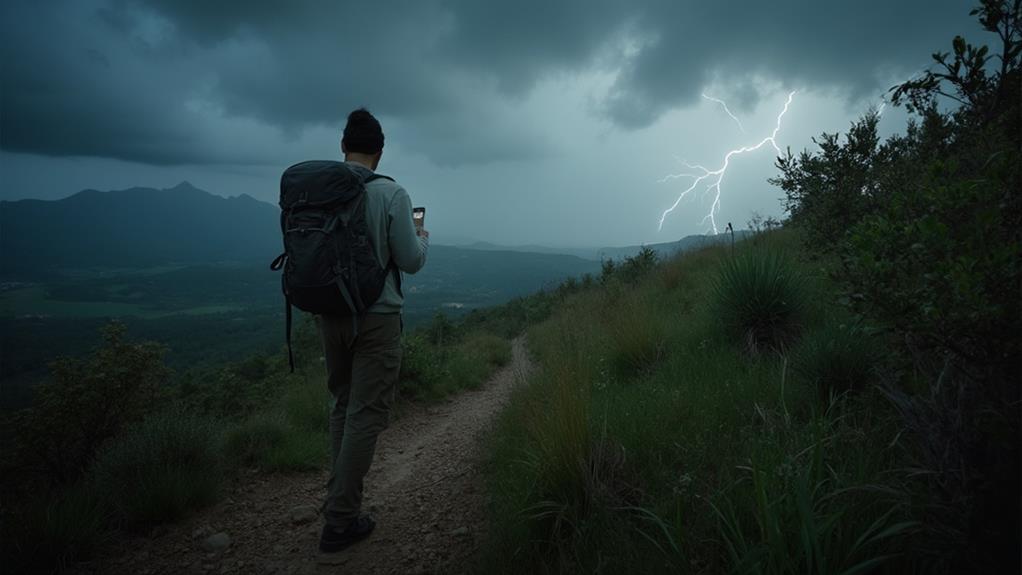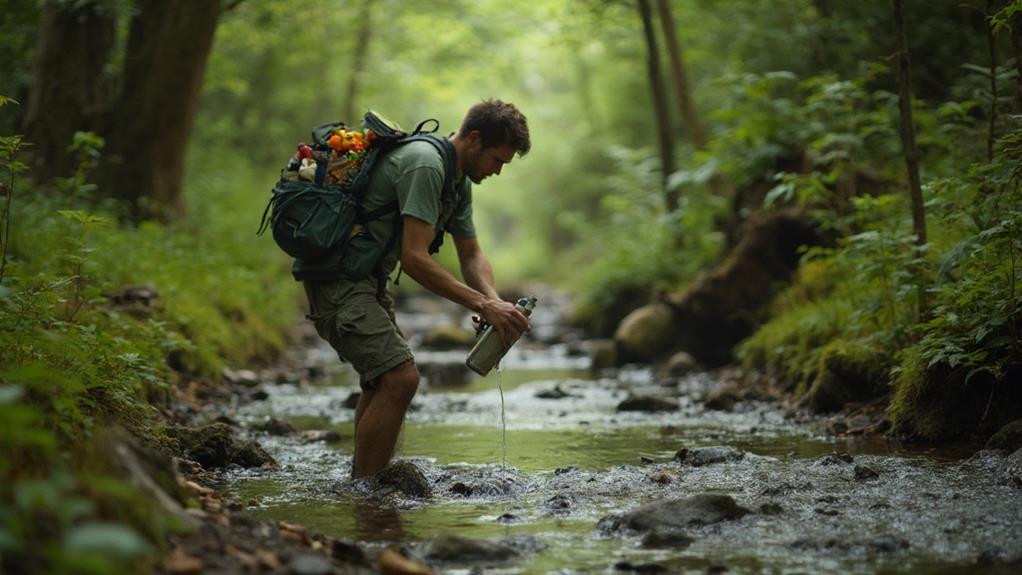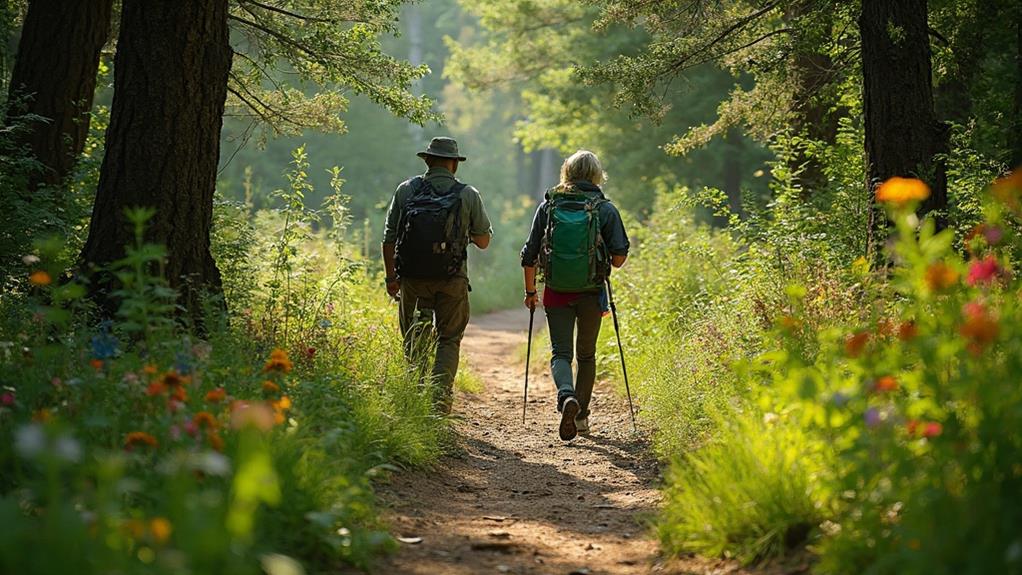To stay safe on the trail, beginners should start with hikes under 5 miles and minimal elevation gain. Use resources like AllTrails for trail details and guarantee you have sturdy boots, adequate water, and a first aid kit. Master basic navigation skills with maps and compass, and review the weather forecast regularly. Inform a trusted contact of your route and expected return time, and be aware of local wildlife. Adhering to trail etiquette, such as yielding to uphill hikers and leashing dogs, is essential. Trust your instincts—prioritizing personal safety enhances the hiking experience. To uncover more insights, continue exploring further guidance.
Key Takeaways
- Choose well-marked, beginner-friendly trails under 5 miles with minimal elevation gain to reduce the risk of getting lost.
- Carry essential gear, including a first aid kit and sufficient water, to stay prepared and hydrated during the hike.
- Familiarize yourself with navigation basics, such as map reading and compass use, to navigate the trail confidently.
- Check weather forecasts and dress in layers to prepare for changing conditions and ensure comfort.
- Inform a trusted contact about your hiking plans and expected return time to enhance personal safety.
Choose the Right Trail
Selecting an appropriate trail is essential for ensuring a safe and enjoyable hiking experience, especially for beginners. Understanding trail difficulty is important; novices should aim for hikes under 5 miles with minimal elevation gain. This approach helps build stamina and confidence while reducing the physical strain associated with more challenging routes.
Utilizing platforms like AllTrails or GaiaGPS can be invaluable. These resources provide detailed trail guides with user reviews and difficulty ratings, enabling hikers to make informed decisions.
Beginner tips include familiarizing yourself with the trail's terrain, landmarks, and expected duration. This not only aids in preparation but also enhances the hiking experience by reducing unexpected surprises.
It's equally important to check for any required permits, ensuring compliance with local regulations. Weather conditions should never be overlooked; rescheduling is wise if forecasts predict extreme weather or unsuitable trail conditions.
Choosing well-marked and maintained trails is another key recommendation. Such trails enhance safety, minimizing the risk of getting lost and ensuring a more predictable environment.
Pack Essential Gear

Having selected an appropriate trail, the next step is to secure that you are equipped with the right gear to make your hiking adventure both safe and enjoyable. Gear selection is paramount, starting with investing in sturdy hiking boots that provide essential ankle support and traction. This choice is vital as improper footwear is a leading cause of injuries on the trail.
To manage unexpected situations, a well-stocked first aid kit is indispensable. Confirm it includes bandages, antiseptic wipes, and any personal medications to promptly address minor injuries.
Packing techniques should also prioritize hydration; carry sufficient water, abiding by the general rule of one liter per two hours of hiking. Hydration bladders offer a convenient solution for easy access during your trek.
Dressing appropriately for weather conditions is another essential aspect. Opt for moisture-wicking base layers, insulating middle layers, and a waterproof outer shell to tackle varying weather. These layers guarantee comfort and protection against the elements.
Understand Navigation Basics
Understanding navigation basics is an important skill for any hiker, guaranteeing both safety and confidence on the trail. Mastering navigation techniques, such as map reading and compass use, is fundamental to successfully navigate unfamiliar terrain. Familiarize yourself with both paper maps and GPS devices before starting your hike. Relying solely on technology can be risky in areas with poor signal reception, making traditional methods invaluable.
Here's a quick guide to enhance your navigation skills:
| Navigation Technique | Importance |
|---|---|
| Map Reading | Fundamental for identifying landmarks and potential hazards. |
| Compass Use | Helps orient yourself in unfamiliar areas. |
| GPS Device | Useful, but unreliable in signal-poor areas. |
| Trail Markers | Important for understanding your current location. |
Study the trail map in advance, identifying key landmarks and potential hazards to guarantee a better grasp of your route. During your hike, pay close attention to trail markers and signage, as they provide essential information about your location and direction. Regular practice in reading topographic maps and understanding contour lines will enhance your confidence and safety. Building these skills not only prepares you for unexpected situations but also enriches your overall hiking experience.
Monitor Weather Conditions

Before starting on a hike, regularly checking the weather forecast is essential to guarantee that conditions remain safe, as unexpected weather changes are common, particularly in mountainous regions.
It is important to prepare for potential temperature drops at higher elevations by dressing in layers and carrying gear suitable for colder climates.
Additionally, utilizing reliable weather apps or websites that offer real-time updates can help hikers stay informed and make necessary adjustments to their plans based on current conditions.
Check Forecast Regularly
Checking the weather forecast regularly is an essential aspect of hiking safety, especially for beginners venturing into mountainous or remote areas. Understanding the potential weather conditions before setting out can greatly influence the safety and enjoyment of your hike.
Weather apps are invaluable tools, providing real-time updates and alerts that can help you make informed decisions. These apps can offer critical insights into seasonal trends, allowing hikers to anticipate common weather patterns such as sudden summer thunderstorms or cooler temperatures at higher altitudes.
Mountainous regions are notorious for their rapidly changing weather conditions, which can impact visibility and overall safety. As a result, it's important to check the forecast for temperature fluctuations. The temperature can be markedly cooler at higher elevations, necessitating the proper gear.
Additionally, monitoring for storm alerts is essential during the summer months when thunderstorms can form swiftly, creating hazardous conditions on exposed trails. Wind conditions should also be considered; strong gusts can pose risks by causing falling branches or challenging balance on uneven paths.
Prepare for Weather Changes
During any hiking adventure, being prepared for sudden weather changes is essential to guaranteeing a safe and enjoyable experience.
Weather conditions, especially in mountainous areas, can shift rapidly, with temperatures dropping and storms developing unexpectedly. Here are practical steps to prepare for these changes:
- Check the Weather Forecast: Before you set out, review the latest weather forecasts for your hiking area. This helps anticipate adverse conditions and plan accordingly.
- Recognize Storm Signs: Be vigilant for warning signs of severe weather, such as darkening skies, increased wind, and sudden temperature drops. These indicators suggest potential storms or dangerous conditions.
- Carry Weather Gear: Equip yourself with appropriate gear, including rain jackets and extra layers. This guarantees you're ready for unexpected changes in temperature or precipitation, keeping you dry and comfortable.
- Plan Your Timing: Aim to descend from high terrains by early afternoon, as thunderstorms are more prevalent during the warmer part of the day, particularly in summer months.
Communicate Your Plans

Guaranteeing your safety on the trail starts with effective communication of your hiking plans to trusted contacts.
Before starting on your journey, provide a family member or friend with a detailed itinerary, including your route and expected return time, to make sure someone is aware of your whereabouts in case of emergencies.
To enhance this precaution, utilize GPS tracking devices or smartphone apps that enable real-time location sharing with selected contacts, offering an added layer of security.
Inform Trusted Contacts
Before starting on a hiking adventure, it is essential to inform a trusted friend or family member about your plans to guarantee your safety and peace of mind. This approach is paramount, particularly if you are hiking solo without the support of a hiking buddy system.
By establishing a reliable line of communication, you make certain that someone is aware of your whereabouts and can respond promptly in case of an emergency.
To enhance the effectiveness of this safety measure, consider the following actions:
- Outline your route: Provide a detailed description of your hiking route, including the trailhead location and any significant landmarks. This information will be vital if a search becomes necessary.
- Set check-in intervals: Establish a check-in system where you contact your trusted individual at predetermined times. This practice guarantees that someone knows you are safe at every stage of your hike.
- Share real-time location: Utilize GPS tracking apps to share your location with your contacts in real-time, offering an added layer of security.
- Prepare an emergency contact list: Make sure your contacts have a list of emergency numbers, including local authorities and park rangers, for immediate assistance if required.
Share Hiking Itinerary
Informing a trusted contact about your hiking plans is only part of guaranteeing a successful and safe adventure. The itinerary significance cannot be overstated, as it provides a critical connection to the outside world. Before you set out, detail your hiking itinerary to a friend or family member, including the trail name, expected start and end times, and any planned stops. This information assures that someone is aware of your whereabouts, which is essential in case of emergencies.
When considering sharing methods, technology offers several practical solutions. If hiking alone, communicate your itinerary via text or a messaging app, allowing your chosen contact to track your progress. Utilizing GPS tracking apps further enhances safety, enabling real-time location sharing. This is particularly beneficial if you become lost or face an unexpected situation.
Additionally, it is important to maintain open communication by updating your contact if any changes occur, such as a delayed return time or route alteration. Establishing a check-in system with predetermined times to update your status provides peace of mind for both you and your loved ones.
This thorough communication strategy is a fundamental component of safe hiking practices.
Stay Hydrated and Fueled

As you commence your hiking journey, maintaining proper hydration and nutrition is essential to guaranteeing a safe and enjoyable experience. Implementing effective hydration strategies is vital. Aim to drink at least one liter of water for every two hours of hiking. Adjust this amount based on temperature and exertion levels to avoid dehydration.
It's advisable to drink before you feel thirsty, as thirst is often a late indicator of dehydration. Incorporating energy snacks such as trail mix or energy bars into your preparations will help sustain your stamina. These snacks provide quick, accessible energy, making them ideal companions on the trail.
For a successful hike, consider implementing the following practical tips:
- Pre-hydrate: Drink enough water before starting your hike to guarantee you begin well-hydrated.
- Regular intake: Consume energy snacks at consistent intervals to keep energy levels stable.
- Electrolyte balance: Use electrolyte supplements, particularly on longer hikes or in hot weather, to replace salts lost through sweat.
- Post-hike rehydration: After the hike, drink 16-24 ounces of water within the first hour to replenish lost fluids.
Following these guidelines will help maintain your energy and hydration, enhancing your overall hiking experience.
Be Wildlife Aware

Understanding the behavior of local wildlife is essential for maintaining safety while hiking, as it allows you to anticipate potential encounters and react appropriately.
Maintaining a safe distance from animals is important to prevent provoking defensive behaviors, which could lead to dangerous situations.
Equip yourself with knowledge on how to act during wildlife encounters, such as staying calm and backing away slowly, to guarantee a safe and enjoyable hiking experience.
Understand Animal Behavior
Starting on a hiking adventure requires not only an appreciation for the natural world but also an extensive understanding of the local wildlife behavior to guarantee a safe journey.
By understanding animal behavior, hikers can anticipate wildlife encounters and reduce the risk of dangerous interactions. For instance, bears often avoid humans but can become aggressive if startled or if food is present.
Here are practical steps to enhance your awareness and safety:
- Make Noise: Talking or clapping while hiking alerts animals to your presence, reducing surprise encounters with large animals such as bears and mountain lions.
- Stay Calm: If you encounter wildlife, remain calm and back away slowly. Abrupt movements can provoke defensive behavior, increasing the risk of an adverse encounter.
- Secure Food and Trash: Use bear-proof containers or hang food and trash out of reach to prevent attracting wildlife to your campsite, considerably reducing potential risks.
- Identify Wildlife Signs: Learn to recognize tracks, scat, and feeding signs to gauge animal activity in the area, helping you to avoid potential hazards.
Maintain Safe Distances
Having a deep awareness of animal behavior is the first step in staying safe while hiking, but it is equally important to maintain a safe distance from wildlife to prevent stressful or dangerous encounters.
Maintaining a safe distance of at least 100 yards from large animals such as bears and moose is essential. This precaution helps avoid provoking these creatures or causing them undue stress, which can lead to unpredictable behavior. For deer and smaller animals, keep at least 50 yards away. This distance minimizes the risk of startling them and guarantees both their safety and yours.
Wildlife encounters can be minimized by making noise as you hike. This alerts animals to your presence and reduces the likelihood of surprising them, which could otherwise escalate into a precarious situation.
If you happen to see wildlife on the trail, it is important to remain calm. Back away slowly, and never approach or feed the animals, as such actions can lead to aggressive behavior.
Moreover, familiarize yourself with the local wildlife's behavior and habitats before you set out. Understanding their patterns can be instrumental in avoiding risky encounters, promoting a safer hiking experience.
Practice Trail Etiquette

Practicing proper trail etiquette is essential for guaranteeing an enjoyable and respectful hiking experience for all. Adhering to these guidelines promotes trail respect and wildlife protection, maintaining a harmonious environment for both nature and fellow hikers.
Here are four key practices to keep in mind:
- Yield to Uphill Hikers: When encountering others on the trail, always yield to those moving uphill. This courtesy helps maintain the momentum of ascending hikers and guarantees a smooth flow of traffic.
- Minimize Noise: Keep conversations and noises to a minimum to avoid disturbing wildlife and other hikers. This practice not only respects fellow trail users but also contributes to wildlife protection by preventing unnecessary stress to animals.
- Pack Out Trash: Always carry your trash with you, including biodegradable items like fruit peels. Leaving waste behind can disrupt the natural ecosystem and detract from the trail's beauty.
- Leash Your Dogs: Guarantee your pet is leashed to protect other hikers and wildlife. A leashed dog is less likely to disturb wildlife or cause accidents with other trail users.
Trust Your Instincts

Intuition plays a vital role in ensuring a safe and enjoyable hiking experience, especially for those new to the trails. Trusting your hiking intuition can be a decisive factor in maintaining personal safety.
The National Park Service underscores the importance of intuitive decision-making, particularly when encountering unfamiliar individuals on the trails. Research highlights that many hikers experience discomfort in social interactions, often influenced by societal pressures. By recognizing discomfort, you can navigate these situations more effectively, prioritizing safety over social niceties.
Studies suggest that women, in particular, might face unwanted advances while hiking, making it essential to be attuned to one's instincts. If an encounter feels unsafe or uncomfortable, it is important to prioritize your gut feelings and remove yourself from the situation. Your intuition can serve as a valuable guide, enabling you to make rapid decisions in unpredictable environments.
Engaging in self-awareness and understanding your comfort levels can greatly enhance both your hiking experience and safety. By acknowledging these feelings, you empower yourself to exercise better judgment.
Therefore, fostering a practice of listening to your instincts can not only protect you but also enrich your time spent on the trails.
Embrace the Experience

Setting out on a hiking journey offers an unparalleled opportunity to immerse oneself in nature, fostering a profound connection with the environment.
Embracing the experience goes beyond mere physical activity; it is a journey of mindful moments that can greatly enhance mental well-being. Studies suggest that spending time outdoors can improve mood and cognitive function, making each step a pathway to reducing stress and rejuvenating the spirit.
To fully embrace the hiking experience, consider the following practical tips:
- Pause and Appreciate: Taking short breaks to admire your surroundings can prevent fatigue and rejuvenate your mind, ensuring a more fulfilling hike.
- Engage with Fellow Hikers: Sharing the trail with others not only fosters a sense of community but can also lead to lasting friendships and shared experiences.
- Focus on Sensory Details: Pay attention to the sights and sounds of the trail, which can enhance your nature connection and make each hike memorable.
- Embrace the Unknown: Allow yourself to step outside your comfort zone, encouraging personal growth and resilience, which in turn builds confidence and self-discovery.
Frequently Asked Questions
How to Keep Safe if You Go Hiking?
To guarantee safety while hiking, prioritize trail navigation and emergency preparedness. Inform someone of your plans, carry navigation tools, a first aid kit, sufficient water, and maintain a charged phone for emergencies. Trust instincts to avoid unsafe situations.
What Is the Most Common Mistakes First Time Hikers Make?
First-time hikers commonly make errors in gear selection, often neglecting essentials like water and a first aid kit. Additionally, they frequently overlook trail etiquette, such as informing someone of their plans and checking weather conditions beforehand.
What Safety Precautions Do You Take Before, During, and After a Hike?
Before a hike, engage in pre-hike planning, including mapping routes and setting emergency contacts. During, adhere to marked trails and remain vigilant of hazards. After, perform a thorough tick check and assess for any injuries.
How Can I Hike on My Own Safely?
To safely engage in solo hiking, prioritize emergency preparedness by informing someone of your plans, carrying a charged phone and GPS device, trusting your instincts, studying trail maps, and packing essential safety gear including a first aid kit.
Conclusion
In summary, ensuring safety on the trail requires thoughtful preparation and awareness. Selecting a suitable trail, equipping oneself with essential gear, and understanding navigation are foundational to a secure hiking experience. Staying informed about weather conditions and communicating plans enhances preparedness. Awareness of local wildlife and adherence to trail etiquette foster a respectful outdoor environment. Ultimately, trusting one's instincts and embracing the experience are vital to both safety and enjoyment, allowing for a rewarding and enriching adventure.